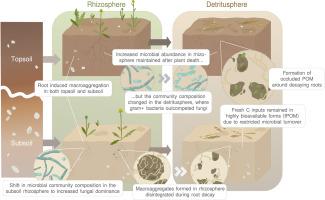当前位置:
X-MOL 学术
›
Soil Biol. Biochem.
›
论文详情
Our official English website, www.x-mol.net, welcomes your
feedback! (Note: you will need to create a separate account there.)
Living and decaying roots as regulators of soil aggregation and organic matter formation—from the rhizosphere to the detritusphere
Soil Biology and Biochemistry ( IF 9.8 ) Pub Date : 2024-06-18 , DOI: 10.1016/j.soilbio.2024.109503 K. Witzgall , F.A. Steiner , B.D. Hesse , N. Riveras-Muñoz , V. Rodríguez , P.P.C. Teixeira , M. Li , R. Oses , O. Seguel , S. Seitz , D. Wagner , T. Scholten , F. Buegger , G. Angst , C.W. Mueller
Soil Biology and Biochemistry ( IF 9.8 ) Pub Date : 2024-06-18 , DOI: 10.1016/j.soilbio.2024.109503 K. Witzgall , F.A. Steiner , B.D. Hesse , N. Riveras-Muñoz , V. Rodríguez , P.P.C. Teixeira , M. Li , R. Oses , O. Seguel , S. Seitz , D. Wagner , T. Scholten , F. Buegger , G. Angst , C.W. Mueller

|
In dryland ecosystems, typically characterized by sparse vegetation and nutrient scarcity, pioneer plants exert a critical role in the build-up of soil carbon (C). Continuous root-derived C inputs, including rhizodeposition and structural root litter, create hotspots of increased microbial activity and nutrient availability where biogeochemical processes, such as soil aggregation and the accumulation and stabilization of organic matter (OM), are promoted. Our study aims to disentangle the effects of root C inputs on soil aggregate formation, microbial community structures, and on the fate of OM—both before and after plant death, during the transition from rhizosphere to detritusphere. This was realized in a two-phase incubation approach, tracing the natural and undisturbed transition from growth to subsequent decomposition of a pioneer plant-root system () in a semi-arid topsoil and subsoil. We quantified water-stable aggregates, investigated the fate and composition of OM separated into particulate and mineral-associated OM fractions (POM and MAOM), and observed successional changes in the root-associated microbiome. Our results underscore the significance of roots as vectors for macroaggregation within the rhizosphere in both topsoil and subsoil, associated with a particularly strong increase in fungal abundance in the subsoil. In topsoil, we identified root legacy effects in the detritusphere, as root-induced macroaggregation persisted after plant death, a phenomenon not observed in subsoil. These root legacy effects were accompanied by a clear succession towards gram + bacteria, which appeared to outcompete fungi during root decomposition. The increased availability of decaying litter surfaces further facilitated the protection of particulate OM via the occlusion into aggregates. Overall, to gain a holistic understanding of plant-microbe-soil interactions, we emphasize the need for more studies that span over the full temporal dimension from living to dying plants in intact soil systems.
中文翻译:

活根和腐烂根作为土壤聚集和有机物形成的调节剂——从根际到碎屑圈
在通常以植被稀疏和养分匮乏为特征的旱地生态系统中,先驱植物在土壤碳(C)的积累中发挥着关键作用。持续的根部来源的碳输入,包括根际沉积和结构性根凋落物,创造了微生物活动和养分可用性增加的热点,促进了生物地球化学过程,例如土壤聚集以及有机质(OM)的积累和稳定。我们的研究旨在阐明根系碳输入对土壤团聚体形成、微生物群落结构以及有机质命运的影响——无论是在植物死亡之前还是之后,以及从根际到碎屑圈的转变过程中。这是通过两阶段孵化方法实现的,追踪半干旱表土和底土中先锋植物根系统()从生长到随后分解的自然且不受干扰的过渡。我们量化了水稳定性聚集体,研究了分离为颗粒和矿物质相关 OM 部分(POM 和 MAOM)的 OM 的命运和组成,并观察了根相关微生物组的连续变化。我们的结果强调了根作为根际表土和底土中宏观聚集载体的重要性,与底土中真菌丰度的特别强劲增加相关。在表土中,我们发现了碎屑圈中的根遗留效应,因为根引起的宏观聚集在植物死亡后持续存在,这种现象在底土中没有观察到。这些根部遗留效应伴随着向革兰氏+细菌的明显演替,革兰氏+细菌在根部分解过程中似乎胜过了真菌。 腐烂的垃圾表面的可用性增加,进一步促进了通过吸收到聚集体中来保护颗粒状 OM。总的来说,为了全面了解植物-微生物-土壤相互作用,我们强调需要进行更多研究,涵盖完整土壤系统中从活植物到垂死植物的整个时间维度。
更新日期:2024-06-18
中文翻译:

活根和腐烂根作为土壤聚集和有机物形成的调节剂——从根际到碎屑圈
在通常以植被稀疏和养分匮乏为特征的旱地生态系统中,先驱植物在土壤碳(C)的积累中发挥着关键作用。持续的根部来源的碳输入,包括根际沉积和结构性根凋落物,创造了微生物活动和养分可用性增加的热点,促进了生物地球化学过程,例如土壤聚集以及有机质(OM)的积累和稳定。我们的研究旨在阐明根系碳输入对土壤团聚体形成、微生物群落结构以及有机质命运的影响——无论是在植物死亡之前还是之后,以及从根际到碎屑圈的转变过程中。这是通过两阶段孵化方法实现的,追踪半干旱表土和底土中先锋植物根系统()从生长到随后分解的自然且不受干扰的过渡。我们量化了水稳定性聚集体,研究了分离为颗粒和矿物质相关 OM 部分(POM 和 MAOM)的 OM 的命运和组成,并观察了根相关微生物组的连续变化。我们的结果强调了根作为根际表土和底土中宏观聚集载体的重要性,与底土中真菌丰度的特别强劲增加相关。在表土中,我们发现了碎屑圈中的根遗留效应,因为根引起的宏观聚集在植物死亡后持续存在,这种现象在底土中没有观察到。这些根部遗留效应伴随着向革兰氏+细菌的明显演替,革兰氏+细菌在根部分解过程中似乎胜过了真菌。 腐烂的垃圾表面的可用性增加,进一步促进了通过吸收到聚集体中来保护颗粒状 OM。总的来说,为了全面了解植物-微生物-土壤相互作用,我们强调需要进行更多研究,涵盖完整土壤系统中从活植物到垂死植物的整个时间维度。































 京公网安备 11010802027423号
京公网安备 11010802027423号